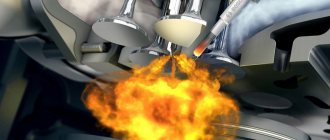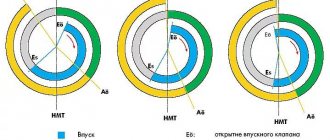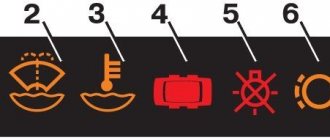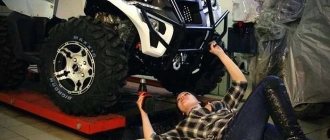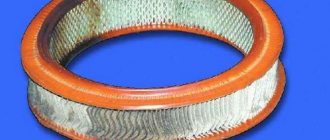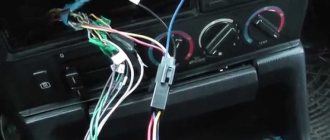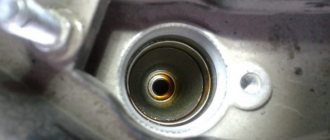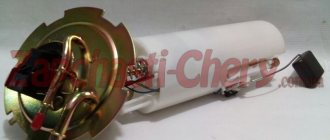Fuel system overflow
When the carburetor delivers too much gasoline, some of the fuel and air mixture enters the exhaust manifold and the engine shoots out the exhaust pipe. Typically, such a problem is diagnosed by the pronounced smell of gasoline in the cabin and under the hood, as well as by the black sooty electrodes of the spark plugs. At the same time, black smoke comes out of the exhaust pipe, often mixed with soot.
The first thing to do is check the air filter. When it is heavily clogged, the engine draws in more fuel than necessary. It could also be that the needle valve inside the float chamber has lost seal or that the pump diaphragm has ruptured.
If there is an excessive supply of gasoline, the idle speed fluctuates or increases to 2-2.5 thousand per minute. When releasing the gas while driving, the problem of shots also arises if the speed is turned on.
Timing belt slipped
If the exhaust system starts shooting, you can’t dismiss problems with the timing belt.
As noted, one of the reasons for such a malfunction is malfunctions in the gas distribution mechanism.
As a result, the exhaust valve opens before the fuel has time to burn, and the remaining fuel burns out in the exhaust pipe.
The likely cause of such failures is stretching and slipping of the timing belt.
If shots in the muffler occur only on a warm engine, but not on a cold engine, we can confidently talk about problems in the timing belt.
POPPING IN THE CARBURETOR WHEN AUDI 80 B2 GAS SHARP, Why is there a popping sound in the carburetor?
It is quite obvious that the appearance of popping noises in the carburetor is an alarming symptom that requires immediate identification and elimination of the existing problem. Let us add that shots or pops can quickly damage the carburetor itself, so further operation of the car is not recommended. In addition, pops and shots in the muffler are accompanied by increased fuel consumption, and this, as you understand, leads to unnecessary expenses. At the same time, the engine starts, although with difficulty, but during its operation the carburetor fires, repeating these pops with a certain frequency. I turned the ignition, it still fires in all positions.
A fairly common problem with carburetor cars is the characteristic popping noise in the carburetor. The malfunction may occur when the engine starts and fires into the carburetor, as well as during operation of the internal combustion engine after the power unit has been started. The reason lies in excessive wear of the distributor bearings. The precise engagement of the drive gear and the correct location of the distributor-chopper in its normal place have a strong influence on the functions of the ignition system. Read more: “The procedure for connecting high-voltage wires to the distributor cover on VAZ 2108, 2109, 21099 vehicles.” In such a situation, to quickly diagnose a malfunction, the easiest way is to temporarily replace the distributor with a known good one. This device may have a number of problems in the form of a breakdown of the distributor cover, a failed slider or high-voltage wires at the place of their attachment.
When it warms up, then:: At high speeds there are small pops in the carburetor; : when you press the gas sharply, there is a failure, sometimes there is a strong exhaust into the carburetor, then the engine picks up speed. Popping noises can be observed not only in the carburetor, but also in the muffler. This unpleasant phenomenon is treated by adjusting the thermal gap. If the spark plugs are white, with carbon deposits, etc., then the OZ needs to be checked and set by adjusting the ignition timing. This adjustment is made by turning the distributor in accordance with the scale.
Recently, when changing gears and sharply pressing the gas pedal, sometimes popping noises appear in the carburetor. In addition, the burning out remains of the mixture ignite the next volume of fuel charge entering the engine combustion chamber from the carburetor to the intake manifold at the moment of fuel intake. As a result, cotton is created in the intake, which reaches the mixing chamber of the carburetor itself. It should also be remembered that a lean working mixture is one of the main reasons for engine overheating.
Another option is the possibility of popping sounds in the muffler if incomplete combustion of fuel occurs. It ignites a new combustible mixture. Combustion occurs in the intake manifold and the engine shoots into the carburetor. At the same time, an increase in engine temperature is observed. Due to such a failure, the fuel mixture is ignited when the intake valves open.
In the first case, popping noises in the carburetor appear during a test run of the engine after repair. In the second case, the malfunction comes gradually. Initially, for example, when you press the gas pedal, short popping sounds appear, which become longer each time.
Due to my profession, I don’t have to set the ignition to a single thousand PAZs. I repeat - the pops only occur when you press the pedal.
When operating their vehicles, in practice, many car drivers quite often encounter the fact that the car shoots into the carburetor. Loud popping noises can be heard either when starting the engine, or when the engine is already warm when driving on the freeway. Then a smooth throttle change - one or more bangs and the engine starts to pick up speed again.
Not a fact, on my own I turned it from - to until the engine stopped, so when it was late, when the throttle was sharply opened, it plugged, and then there were pops in both the carb and exhaust. 100% was not confirmed, I took the valve head to be ground in, the 1st and 3rd outlets sweated slightly and they were ground in - nothing has changed, the defect remains. 6. If the compression is bad, we go to a neighbor’s mechanic and agree on repairs/maintenance/cylinder head. Then we do this, press the accelerator pedal sharply and almost all the way: First the speed drops and then rises sharply.
If it “shoots” in the resonator of a Chevrolet Niva car
The shniva requires special attention and repair, if the idle speed is uneven, problems with power arise, and gasoline consumption unreasonably increases.
Such “symptoms” are explained by breakdowns of the electric pump, injectors, and spark plugs in the cylinders. A side effect is that when gas is released, the contents of the combustion chambers enter the muffler and explode. Shnivy owners are trying to diagnose their car themselves. To do this, you need to start the car. The exhaust sound at idle should be smooth and uniform. When gas is released, fuel enters the muffler, micro-explosions can be clearly heard - there is a problem, there is no spark at the spark plug, compression in the cylinder has noticeably decreased. Irregular sounds indicate heavily contaminated injector nozzles and worn-out spark plugs. You can replace them yourself.
When re-gasping, popping noises in the muffler are regular - you need to turn off the engine and make sure that the ignition wires are in working condition. Damaged insulation, wire, oxidized tips need to be replaced.
After minor repairs, gasoline continues to flow into the muffler when the gas is released, popping sounds are heard - in-depth diagnostics are required at a service station. Over time, explosions occur more often, and car problems get worse. Visiting a service station earlier is a way to prevent serious engine problems.
On domestic motorcycles, a problem often arises associated with the appearance of loud sounds in the muffler. Even drivers of foreign vehicles often suffer from “machine gun bursts” that accompany a sharp increase or decrease in speed. Getting rid of this trouble can be quite difficult. However, if you understand why a motorcycle shoots its muffler, you can eliminate loud noises that disturb public peace.
Other reasons
There are a number of other reasons why a characteristic “shot” in the exhaust pipe may occur:
- The engine idling noise can occur due to two additional reasons. The first of them is a violation of the tightness of the intake manifold. The second is that the idle system itself is clogged.
- Low-quality gasoline or fuel with a low octane number can cause popping noises. It is best to refuel at reputable gas stations.
- Mixed spark plug wires. When replacing, checking or installing spark plugs, it may happen that the connected wires are mixed up. This may well be the cause of popping noises in the muffler. A characteristic feature of this particular problem is not only the “shot”, but also the fact that the car will not start at all.
- People who have an economizer installed in their system often encounter this problem. If it is available, then it is worth checking it.
- In some cases, popping noises in the exhaust pipe are caused by a malfunction of the air damper. If so, then it needs to be adjusted.
- If popping noises occur only when releasing gas, then there is a separate reason for this, which lies in the fact that the exhaust pipe of the muffler (or simply “pants”) is poorly screwed to the exhaust manifold. It is necessary to check the tightness of this connection and, if necessary, seal it, tighten it, etc.
- Another common cause is that the fuel injectors are too efficient. Drivers often say in such cases that they are “flowing.” In this case, they simply supply too much gasoline at once, which is why, even with normal spark power, it does not have time to burn before the exhaust valve opens. Therefore, fuel seeps into the pipe where the popping occurs. There is an easy way to check this defect. At high engine speeds and with the gas pedal pressed, try to start it (the so-called purge mode). If a popping noise occurs at these moments, then at least one of the injectors is leaking.
- As for other reasons for injection systems, there is such an issue as knock sensor fatigue, due to which ignition may occur too late. In addition, it may not respond correctly to extraneous noise occurring in the engine. Its performance can only be checked using computer diagnostics.
Cars with fiery exhaust
Although the fire styling from the muffler looks incredible, a car with a fire exhaust requires proper tuning. Otherwise, at best, the exhaust will not work correctly, at worst, it will have a detrimental effect on the exhaust system and engine operation. Also, an incorrectly adjusted exhaust on a car with fire can lead to a fire in the car.
Make a shooting exhaust on a car
It is not difficult to fire from the muffler even in cars with standard factory equipment. There are several ways to make a car shoot at the muffler. First of all, it is necessary to ensure that the fuel can enter directly into the exhaust system. To do this, you can press the gas to the floor on the car, warm up the engine, turn off the ignition and press the gas. Since there are no flares in the cylinder block, fuel will flow directly into the exhaust system. As soon as the speed drops, immediately turn on the ignition to avoid stalling the car.
DIY exhaust
You can also unscrew a couple of spark plugs and close them with plugs so that there is no fuel in the engine compartment. It is necessary to select 2 cylinders opposite each other. One of them will be at top dead center, the other at bottom dead center. This way, the engine will work correctly, and we can make a shooting muffler for the car.
Make a shooting car muffler
We've sorted out the fuel, all that remains is to add fire to the exhaust. It's easy to do this:
- You need to run another wire from the ignition coil to connect an additional coil.
- In the exhaust pipe, 10 cm from the edge, you need to drill a hole for the spark plug bushing.
- It is necessary to securely fasten it all, weld it, screw the nut under the spark plug and install the spark plug. The fiery exhaust is ready.
True, if it works constantly, it is very dangerous. Therefore, the ignition coil wire is disconnected and installed on a separate switch in the cabin.
Make the car shoot out the muffler
Of course, not everyone understands the structure of a car, and for non-professionals making a fire exhaust system with their own hands seems very difficult. That is why there are universal ready-made solutions that consist of a block for a car with a fiery exhaust.
Anyone can buy such a product, and even the most inexperienced driver can be confident in their own safety. But only after reading the instructions and following the rules. They indicate that the system cannot be used for more than 3 seconds in manual mode to protect the engine and exhaust system. It is also not recommended to use it when there are any objects, people or cars nearby.
Exhaust block
All responsibility for the damage caused falls on the shoulders of the owner of the car. The instructions for use also state that this device is recommended for use only at special displays and not on public roads.
Fuel system
If the fuel mixture does not enter the cylinder, but the spark plug works normally, this may mean that:
- The fuel filter is clogged.
To clean this unit, remove the fuel hose and check the flow. If it is weak, the filter must be removed through the filler hole of the fuel tank and cleaned or replaced if completely worn out.
- The breather is clogged.
We invite you to familiarize yourself with Apple tree yellow sugar description photo reviews
This is nothing more than a hole in the fuel tank cap, which is cleaned with an awl.
- The fuel mixture is not supplied or is supplied in insufficient quantities.
There may be several reasons for this:
- the air filter is clogged (in this case, it must be removed, washed with water, dried and replaced);
- the carburetor settings have gone wrong (which means this unit needs to be adjusted again);
- the integrity of the carburetor membrane is damaged (must be replaced);
- the carburetor channels are clogged (it must be disassembled and all parts and components cleaned).
If the chainsaw engine does not start or cannot develop normal power, it is likely that there is not enough pressure in the engine cylinder to burn the fuel mixture. The reason for this may be wear of the elements of the cylinder-piston group - piston, rings, bearings, etc. In order to assess the condition of this unit, it should be visually inspected after first removing the muffler.
For a more complete diagnosis, a compression gauge is placed in the spark plug hole of a two-stroke chainsaw engine. It is used to measure compression in the engine. Based on the test results, one can judge the condition of the CPG, but accurate facts can only be obtained by completely disassembling the unit.
Most of the malfunctions of gasoline chain saws can be fixed with your own hands. True, this requires an understanding of the structure of the chainsaw and how the components function among themselves. As for the tools, the most often needed are:
- screwdrivers (slotted and power);
- combination wrench included in the kit or regular wrenches with heads of various sizes.
Malfunctions of the fuel system are also quite often the main reason that prevents a chainsaw from working as efficiently as possible. First of all, you need to check the quality of the fuel mixture.
If full-fledged gasoline streams appear, then there is a high probability that you will have to change the burst hose connecting the carburetor and the fuel tank.
There are several reasons why the fuel mixture stopped flowing into the cylinder:
- The air filter is clogged.
- The carburetor settings have been lost.
- The carburetor membrane is no longer intact.
- The channels through which gasoline is transported are clogged.
It's no secret that expensive imported chainsaws are very sensitive to low-quality fuel. At the same time, tool owners are the last ones to blame local diesel fuel, considering regular jamming of the saw as a sign of failure of mechanical parts.
Many manufacturers even block users' access to the carburetor so that they do not change the composition of the air-fuel mixture themselves. For this purpose, the jets (holes for supplying the mixture) are made unadjustable.
Fill your chainsaw with fuel recommended by the manufacturer.
Therefore, always prepare a fuel mixture of high-quality gasoline and oil of the brands recommended by the manufacturer. There is no need to prepare the fuel mixture for future use - its quantity should be enough for a couple of weeks of work. Gasoline “stayed” in a canister for a month loses its octane characteristics and the saw is guaranteed to jam.
In the picture we see:
- cylinder,
- piston,
- piston pin,
- compression ring,
- retaining rings.
The engine cylinder serves to burn the fuel-air mixture. When the exhaust gases burn, they push the piston, and it directly transmits force to the engine crankshaft.
The compression ring provides sufficient pressure in the combustion chamber for engine operation.
The piston pin holds the piston, and the retaining rings secure it.
The essence of the problem
Most often, loud pops in the muffler of two-wheeled vehicles are heard when a lean mixture is supplied to the engine. The reason for its formation may be the use of low-quality gasoline, saturated with water and non-flammable impurities, or incorrect adjustment of the intake system. The air-fuel mixture burns only partially - its remains splash out into the hot muffler, where they explode with sharp, unpleasant sounds. A symptom of a lean mixture is popping sounds in bursts, which intensify as the speed increases.
In powerful motorcycles, the completely opposite problem is more common, associated with the supply of an excessively rich mixture. There is not enough oxygen for its combustion, which leads to the deposition of gasoline condensate on the walls of the muffler. When the “critical mass” is reached, the fuel outside the engine ignites, resulting in one loud bang. If the problem is not corrected, within 1–2 months the contents of the muffler will simply burn out and it will turn into a “direct flow”.
Gazelle
Model ZMZ 40524.10 is a gazelle carburetor known to everyone. The car brand “Gazelle” is one of the most popular and affordable trucks in Russia, which were originally intended for transporting not very large loads. Due to the huge number of such machines, we will consider several nuances of different gazelle systems. For example, a microprocessor ignition system, which is installed on the 406 model.
If the driver claims that his car makes some popping noises, jerking noises and loses its power. In this case, the power system, engine and ignition system should be checked. We checked the carburetor with a gas analyzer not during the operation of the 1st and 2nd chambers, cutoff, enrichment and during idling and did not find any violations. Next they check the engine. When checking the compression, no problems were identified, but the next time deviations from the norm were detected. It was concluded that the jerks and pops that the driver did not like were due to the jumping of the teeth of the upper chain.
Carburetor ZMZ 406 series
What to do if a gazelle loses power?
From the very beginning, you need to check how the diagnostic circuit and the on-board diagnostic system function, because when the travel image mode is activated, a malfunction code of 12 should be obtained. To read the code, the 10th and 12th contacts of the diagnostic block must be closed. Using a diagnostic toaster, engine sensor parameters are measured and then compared with typical values for average engines. The most common reason for a decrease in car power is contamination of the tube that connects the intake manifold and the pressure sensor.
Gazelle ignition system
The microprocessor ignition system ignites the working fluid in the cylinders and sets the required vehicle ignition timing for all engine modes. The ignition system performs the function of regulating the operation of the forced idle economizer. Thanks to the ignition system, engine operation becomes more economical, compliance with all exhaust gas toxicity standards is monitored, detonation is eliminated and the vehicle's power is increased. If we compare the classic system with this one, then this ignition system is much more reliable and durable. Here only the spark plugs can wear out.
How does diagnostic mode work?
When the ignition system is turned on, the indicator light begins to light. At that very moment, the diagnostic system begins to work. If the system is working properly, the light stops lighting, but otherwise it continues to light. That is, an extinguished warning light indicates that the ignition system is absolutely working.
Carburetor ZMZ 406 series
Why does the 406 engine sometimes not start during a freeze?
The most common reasons why the 406 engine does not start:
- Poor quality oil;
- The battery is not powerful enough, which prevents the engine from starting;
- Faulty starter;
- Misregulated ignition system;
- Poor quality gasoline;
- Failure to supply gasoline.
How to adjust the carburetor?
- Disconnect the choke actuator cord;
- Remove the air filter and carburetor cap;
- Check the level of the float chamber, it should be below 3 centimeters from the edges;
- Remove the plug from the float rod;
- Make sure the valve seal ring is tight;
- Install the carburetor top;
- Install the choke cable and air filter;
- Screw in the idle speed adjustment screw all the way, unscrewing it five turns. Carry out the same actions with the quality screw, but unscrew it three turns;
- Start the power unit;
- Let it heat up to 90⁰;
- By rotating the operational adjustment screw, select the crankshaft speed, about 700 rpm;
- Press the accelerator pedal and release quickly. If the engine stalls, increase the frequency;
- Stop by a car dealership and adjust the CO and CH of the engine.
The appearance of popping noises in the carburetor is usually accompanied by unstable engine operation, floating idle speed, increased fuel consumption and the car losing its previous dynamic characteristics. In some cases, the engine does not start at all, or stalls immediately after starting, not responding to pressing the gas pedal.
Irregularities in the timing phases: definition
One of the main problems can be called even the slightest disruption in the operation of the gas distribution mechanism phases. The same thing happens in the fuel combustion chamber as with an incorrectly adjusted ignition. The exhaust valve is already open, and the fuel in the chamber has not yet burned out. As a result, gasoline goes to burn out into the muffler pipe.
A phase cannot simply fail. This is facilitated by the presence of accompanying reasons. Signs of a malfunction of the gas distribution mechanism include metallic knocks, which are not typical for engine operation at low speeds. Compression in the cylinder block decreases. The reason for the appearance of additional noise and popping noises in the muffler may be wear of the chain or belt (instructions for replacing the belt), which rotates the camshaft. Possible wear on the toothed pulley.
If these symptoms are present, you need to pay attention to the valves themselves. When refueling with low-quality gasoline, the valves become covered with heavy carbon deposits. This interferes with the normal operation of the entire mechanism. Sticking valve springs cause the engine to overheat.
The valves should be carefully checked for mechanical damage. If there are visible roughness or bends in the valve plate, they need to be ground in. Significant scratches will require sanding or replacement with new parts.
To clean carbon deposits, you can use a scraper after soaking the valves in kerosene.
Additional reasons
There are a number of other reasons why the exhaust pipe shoots. These include:
- Popping noises when idling the engine are possible for two reasons - a leak in the intake manifold, as well as a clogged idle system.
- Poor quality gasoline or gasoline with a low octane number. Try to refuel at reputable gas stations and use fuel recommended by the manufacturer of your car.
- Mixed spark plug wires. If, when replacing or checking spark plugs, you mixed up the wires connected to them, this will also be a likely cause of popping noises. In this case, the car may not start and “shoot” at the muffler.
- If your machine has an economizer, check its operation. Often the malfunction of this unit is also the cause of “shots”.
- Malfunction of the air damper. Check this element and adjust if necessary.
- One of the reasons when the muffler shoots when releasing gas is that the muffler downpipe (“pants”) is poorly screwed to the exhaust manifold. Check the tightness of the connection and tighten it if necessary.
- Another likely cause of popping noises is high performance fuel injectors (“leaking”). They supply too much fuel, which does not have time to burn completely, which leads to “shots”. There is a simple way to check. It is necessary to try to start the engine at high engine speeds (with the gas pedal depressed) (the so-called purge mode). If popping noises occur at this time, it means that at least one injector is leaking.
- In injection cars, late ignition and, as a result, popping noises can be caused by “fatigue” of the knock sensor. It can also respond to extraneous noises occurring in the engine. The operation of the sensor must be checked using computer diagnostics.
- If the muffler shoots when releasing gas, then one of the most common reasons for this is “burning” of the exhaust valves. Popping noises may also appear when descending a mountain in gear. Inspect and clean them.
- If your car uses a contact ignition system, then you need to check the gap on its contacts. Ignition problems, as described above, may be the reason that not all of the gasoline is burned.
- Leakage of the gas exhaust system. In this case, as a rule, single pops occur when the gas is released. First of all, check the gaskets at the connections of the pipes (catalyst, resonator, muffler).
Also, if lumbago occurs and traction deteriorates, it is recommended to check the fuel pressure in the system, as well as compression (cylinder tightness for leaks), and inspect the ignition coil.
Condensation in the muffler
The main reason for the formation of condensation in the muffler is the temperature difference between the ambient air and the muffler. Its formation in a car with a working catalyst is a natural phenomenon. It’s worse if it’s not there, but too much can cause corrosion. There is a Read more
As you can see, there are many reasons why a muffler shoots. Therefore, we advise you to start your diagnostics by checking the tightness of the exhaust system. Inspect the bolted connections and gaskets between its individual elements. This will save you time and money. This is especially true if popping noises are heard when releasing the gas or when descending a mountain in gear (when braking the engine).
If the audit does not give positive results, then it is necessary to check the operation of the carburetor, valves and other parts described above. This check is advisable if the muffler shoots when you press the gas.
Curious incidents with fire cars
Installing your own fiery exhaust on a car is an opportunity to make the car start challenging and daring. But don't forget about safety. There are those who want to save on installing a flame exhaust and do it themselves, without even basic skills and knowledge. It's good if everything is installed correctly.
But accidents often occur when car bumpers or tires catch fire. Only after this does the realization come that it was not worth saving on installing the system. When a car catches fire from a fire in the muffler, you may panic and think that if you drive faster, the flame will immediately go out. But in practice, the flame only burns hotter.
Source
Reason and solution
The easiest way to get rid of pops on a carburetor motorcycle is to simply move the needle valve to a different position, changing the degree of saturation of the mixture with gasoline. It is better to entrust this operation to a specialist, since not everyone can fine-tune the carburetor. If there is electronic fuel injection, it is impossible to change the gasoline supply parameters yourself - the control unit will have to be flashed at a specialized service station.
It happens that the motorcycle shoots into the muffler and carburetor - this is often found on domestic Urals and imported choppers with a large cylinder capacity. The problem is a clogged air-fuel mixture at the inlet. To eliminate it, it is worth changing the filters and sealing gaskets, and also checking how tightly the pipes fit to the inlet fittings and whether there are any large cracks in them.
Very often, popping noises appear after replacing the muffler with a non-standard one or cutting holes in it to eliminate resistance to escaping exhaust gases. Particularly unpleasant sounds appear when installing a “direct flow”. The reason is the creation of a strong vacuum, which leads to a lean air-fuel mixture. Powerful imported motorcycles often use an exhaust gas afterburning system, which reduces their toxicity - after removing the standard muffler, its operation becomes clearly audible. To eliminate shots after changing the silencer, you must:
- Reconfigure the carburetor or reflash the control unit;
- Install filters with a different capacity;
- Disable the exhaust gas afterburning system.
On sports motorcycles whose engines run at high speeds, the problem with shots may be related to the speed limiter or crankshaft speed limiter. When a certain indicator is reached, the fuel supply may remain unchanged for some time, while the number of flares is reduced. Accordingly, a huge amount of gasoline enters the muffler, which explodes with a jerky sound, forming a “machine gun burst.” It can be heard especially well when releasing the gas after active acceleration. It is impossible to eliminate such a problem without reducing the life of the engine - you have to change your driving style so as not to irritate yourself and others with unpleasant loud bangs.
It is worth paying attention to the ignition system - missed flashes may be due to its malfunction. Carefully inspect the high-voltage wires - there should be no cracks or peeling of insulation on them
After unscrewing the spark plugs, check to see if there is a specific deposit on their surface that appears when using low-quality gasoline or when the ignition timing is set incorrectly. If the motorcycle is equipped with an electronic ignition system, the problem can often be solved by reprogramming the control unit. Some motorcycle owners decide to make drastic changes by installing a new control unit with preset sport settings - this solves the problem of shots in the muffler, and also increases engine power and improves dynamic characteristics.
Causes of fuel microexplosions outside the engine
- The contents of the combustion chambers penetrate the muffler when gas is released if the ignition timing is set incorrectly. A few degrees of error is enough for such an unpleasant phenomenon to occur. Automatic adjustment of this parameter is rare in most modern vehicles.
- Unburnt material enters the muffler when gas is released because the ignition module is broken. The operation of the engine pistons is not synchronized with the supply of a spark. The more serious the violation, the more regularly the characteristic clapping sound is heard.
- The on-board computer is faulty. The electronics give false signals and the fuel does not have time to burn. When revving the throttle, the popping noise in the muffler is especially audible.
- The problem is in the spark plug wires. The driver violated the order of their joining. Popping noises in the muffler when releasing gas appear immediately after improper handling of spark plugs.
- The camshaft and valves are worn out, poorly fitted, and have cracks. Through them, the contents of the combustion chambers penetrate into the muffler when gas is released. In such a situation, a characteristic popping sound is heard when heating up and further driving.
- Violations in electronic control of valve timing. More and more unburnt material will end up in the muffler when the gas is released. Debugging required.
- A timing belt tooth has come off. The gear clings weakly to the part and slippage occurs.
- Slippage occurs because the timing belt has become too stretched.
- The timing settings are incorrect, the exhaust channels open early, the pressure pushes part of the combustible mixture into the muffler when the gas is released. The reason is typical for VAZs. Special recesses prevent the valves from bending, and gas distribution rarely fails. Suspicion of a timing belt failure is a reason to immediately go to a service station. Further operation leads to failure of pistons, valves, and the need for major repairs of the heart of the vehicle - the engine. Popping noises in the muffler when releasing gas indicate probable major problems.
- Quiet crackling pops in the muffler at idle occur when there is minor damage to the damper or gasket under the manifold.
- Failure of the carburetor float chamber needle valve leads to gasoline leaking into the muffler when gas is released.
- The carburetor malfunctions because the throttle valve is not adjusted; an excessive amount of fuel is supplied to the cylinders, which flies into the muffler when the gas is released.
- Clogged carburetor air filter. A simple problem that can easily be fixed on your own.
- Does the car have an injector? Gasoline enters the muffler during gas release due to sensor failure. In a normal situation, they control the flow of the air-fuel mixture. Why does the muffler shoot? There is too much fuel and not enough air in the mixture. Explosions also occur at idle speed. In fuel-injected cars, problems with fuel explosions in the exhaust system rarely occur.
- The seal of the motor float is broken.
- Parts of the idle system - the channel, the air jet - are clogged. When gas is released, gasoline enters the muffler and a characteristic sound is heard.
- The economizer is not working properly.
Conclusion: the most likely “culprits” for the fact that the contents of the combustion chambers get into the muffler when venting gas are the ignition system, timing belt, carburetor. The driver can independently replace the air filter and adjust the carburetor valves. It didn’t help - urgently go to the service station. Manufacturers recommend visiting auto mechanics as soon as it is discovered that fuel gets into the muffler when venting gas. The locksmith will conduct professional diagnostics and eliminate the problem. There is no point in postponing, risking the serviceability of the car, or your own life. True, in some situations you can try to cope on your own.
shots into the silencer
Opposition brothers! Help with advice. A dragon has taken up residence in the engine. The infection spits fire from the silencers. Everything happened after I made capital improvements to the engine (MT-11). The timing belt has been rummaged through and gutted, the valve clearances have not been adjusted, and 0.07 and 0.1 and 0.05 + various combinations. Ignition BSZ - twisted, spit, set different gaps, changed spark plugs. Carburetors - adjusted for both lean and rich mixtures, adjusted the level of the float chamber (all the options I found, 13mm from the middle of the float and 26mm from the edge of the body.), set the needle in all positions. I looked through all the forums, none of the advice helped.
Does it pop at high speeds?
Mostly when I let off the gas.
BSZ is probably buggy
I checked, put the contact number, same result
Is the spark plug visible black?
Black with any carb and ignition settings.
spark plugs, breaker, coil - all this needs to be double-checked. and don’t even install contact and don’t even try; it finally doesn’t work on my contact. Why? I don’t know and I don’t even bother, I just went and bought a normal ignition and still no problems.
Look at the air. It can get very boggy due to poor cross-country ability.
the air is new and clean, has not traveled 100 km
Still, set the ignition early, and do everything else later. Shooting into the muffler while releasing gas is the way to go.
I set the early one all the way to the millimeter, and also the later one, there was no result.
shots can only be due to a rich mixture and late ignition! look at the carbs, they overfill 99%
I leaned the mixture, lowered the float level, changed the jets (set smaller diameters) - nothing.
Start it without an air filter (remove the pipes) and you will see the difference.
It seems to me that the whole issue is in the contact oil air vent.
oil-free air, no air, started it - nothing changed
there is only one way out! swap carburetors
impossible, I have a K63T from a Vega prototype, one left and the other right and connected by diffusers through the factory pipe, there is no way to rearrange it, and it doesn’t want to work with other carbs at all.
but I would take off the spit! It doesn’t have any advantages, it just makes things worse.
it is not removable, the carbs are one whole (as intended from the factory) and can only be removed together with the rods, but I can’t plug the holes in the diffusers with a plug). The pereplyuyka divides the air mixture between the carbs and makes them easier to tune (tested). There are no complaints about the way the engine starts, and it runs well (140 with 9 axles makes it easy), but the consumption is about 8 and these damn shots give no rest.
Incorrect thermal clearance
Let's figure out what the significance of the thermal gap is. A car engine is made up of different materials. When heated, each element expands according to its own temperature coefficient. When assembling the unit, the parts are selected in such a way that there is a gap between them; as it heats up, this coefficient is leveled out, and the engine operates ideally in a warm state. This gap is called “thermal”.
An increased gap between valve tappets and camshaft cams leads to engine noise. Due to insufficient valve opening, engine power will be significantly reduced.
But the reduced gap causes those same pops in the muffler. A valve that is not completely closed will allow fuel to flow into the exhaust manifold. Adjusting the valves will help eliminate the problem. It is worth noting that the adjustment must be carried out on a cold engine.
Read more about valve adjustment.
Additional reasons
There are a number of other reasons why the exhaust pipe shoots. These include:
- Popping noises when idling the engine are possible for two reasons - a leak in the intake manifold, as well as a clogged idle system.
- Poor quality gasoline or gasoline with a low octane number. Try to refuel at reputable gas stations and use fuel recommended by the manufacturer of your car.
- Mixed spark plug wires. If, when replacing or checking spark plugs, you mixed up the wires connected to them, this will also be a likely cause of popping noises. In this case, the car may not start and “shoot” at the muffler.
- If your machine has an economizer, check its operation. Often the malfunction of this unit is also the cause of “shots”.
- Malfunction of the air damper. Check this element and adjust if necessary.
- One of the reasons when the muffler shoots when releasing gas is that the muffler downpipe (“pants”) is poorly screwed to the exhaust manifold. Check the tightness of the connection and tighten it if necessary.
- Another likely cause of popping noises is high performance fuel injectors (“leaking”). They supply too much fuel, which does not have time to burn completely, which leads to “shots”. There is a simple way to check. It is necessary to try to start the engine at high engine speeds (with the gas pedal depressed) (the so-called purge mode). If popping noises occur at this time, it means that at least one injector is leaking.
- In injection cars, late ignition and, as a result, popping noises can be caused by “fatigue” of the knock sensor. It can also respond to extraneous noises occurring in the engine. The operation of the sensor must be checked using computer diagnostics.
- If the muffler shoots when releasing gas, then one of the most common reasons for this is “burning” of the exhaust valves. Popping noises may also appear when descending a mountain in gear. Inspect and clean them.
- If your car uses a contact ignition system, then you need to check the gap on its contacts. Ignition problems, as described above, may be the reason that not all of the gasoline is burned.
- Leakage of the gas exhaust system. In this case, as a rule, single pops occur when the gas is released. First of all, check the gaskets at the connections of the pipes (catalyst, resonator, muffler).
Also, if lumbago occurs and traction deteriorates, it is recommended to check the fuel pressure in the system, as well as compression (cylinder tightness for leaks), and inspect the ignition coil.
Condensation in the muffler
The main reason for the formation of condensation in the muffler is the temperature difference between the ambient air and the muffler. Its formation in a car with a working catalyst is a natural phenomenon. It’s worse if it’s not there, but too much can cause corrosion. Yes Read more
As you can see, there are many reasons why a muffler shoots. Therefore, we advise you to start your diagnostics by checking the tightness of the exhaust system. Inspect the bolted connections and gaskets between its individual elements. This will save you time and money. This is especially true if popping noises are heard when releasing the gas or when descending a mountain in gear (when braking the engine).
If the audit does not give positive results, then it is necessary to check the operation of the carburetor, valves and other parts described above. This check is advisable if the muffler shoots when you press the gas.
Popping sounds from cars with HBO
Unfortunately, this problem also affects cars that use liquefied gas as fuel. According to statistics, owners of cars with injection engines and third-generation gas equipment most often encounter it.
Gas pops can be heard both in the intake manifold and in the exhaust system (in particular, in the muffler). There are two main reasons for this:
- There is no stable and sufficient gas supply. This occurs due to incorrect settings of the gas reducer or a clogged air filter. For fuel-injected cars, the culprit may be the mass air flow sensor (MAF). “Glitches” in its operation lead to incorrect operation of the electronics. That is, we get a lean or enriched gas mixture, resulting in popping noises.
- Incorrect ignition angle. In this case, the situation is similar to that described above. If the ignition is late, the muffler “slams”, if it is early, the intake manifold or filter.
Monitor the status of your HBO and its settings. Don't neglect problems when they arise. Otherwise, you may not only face expensive repairs, but also spontaneous combustion of the car’s power unit.
Conclusion
Popping noises from the exhaust pipe are signs of a non-critical, but rather unpleasant “disease”. In addition to external manifestations, the engine and exhaust system deteriorate, and excessive fuel consumption occurs, which leads to unnecessary waste of money for the car owner. Also, if the problem is ignored for a long time, the valve, exhaust pipe, resonator or muffler may burn out. In general, if such a breakdown occurs, the machine can be used, but it is recommended to carry out repair work at the first opportunity. If you cannot or do not want to do them yourself, contact a service station for help.
Source
Why does the silencer shoot: reasons
The main reason for the appearance of pops is incomplete combustion of fuel. Once it enters the exhaust system, it ignites. The process is accompanied by a noise similar to cotton. The force of the explosion depends on the amount of unburned fuel. Sometimes you can even hear a whole line of shots. By the way, sometimes it shoots into the muffler when the gas is suddenly released or when you press it - and a lot of smoke comes out of the exhaust pipe. A breakdown is indicated by a loss of internal combustion engine power and an increase in fuel consumption.
There are other reasons why popping occurs.
Air filter
The fuel mixture is formed from fuel and air - the components must be mixed in certain proportions. The filter does not allow air to pass through if it is clogged. As a result, the lack of oxygen will lead to incomplete combustion of the fuel. Through the manifold, the fuel enters the exhaust system, where an explosion occurs as a result of heating.
Carburetor
An explosion in the exhaust system can also occur due to incorrect carburetor settings. The purpose of the unit is to form the correct air-fuel mixture. There should not be a lot of fuel in the mixture, otherwise everything described in the previous paragraph will happen. Popping noises will only be heard when the gas is released.
Jets
Jets are filter elements that allow air mass to pass through them. They are used in carburetor engines. There are 2 common causes of malfunction: clogging due to prolonged use and incorrect settings. This leads to a lack of oxygen and incomplete combustion of the fuel - as is the case with air filters. Due to the lack of oxygen, the mixture becomes oversaturated with gasoline - hence the popping noise.
Ignition system
This node also needs to be configured properly. Usually “shots” are a consequence of late ignition. The point is this: a spark is formed when the supply valve is fully opened. This causes fuel to enter the manifold, and then into the exhaust. With early ignition, “shots” can also occur, but only in the air filter. Explosions in the muffler due to late ignition lead to burnout of the intake valve.
Candles
Incomplete combustion of fuel may occur due to insufficient spark. Possible reasons:
- Poor contact at wire terminals.
- Distributor malfunction.
- Spark plug failure. Even one burnt element can seriously affect sparking. As a result, a weak spark will be produced, and the fuel will not burn out completely.
Thermal gap
Thermal gap is the permissible gap between the parts of the motor when heating. It can be observed between the camshaft lobes and valve lifters. The gap must be adjusted according to specifications.
Indirect signs of an increase in the gap are a decrease in engine power and increased noise during operation. Insufficient clearance causes “shots” in the exhaust. The logic of what is happening is as follows: if the valve is not completely closed, part of the fuel will pass through it into the manifold, and from there into the exhaust.
timing belt
If the gas distribution mechanism is not adjusted, popping noises in the exhaust system are inevitable. The problems that precede the failure of the timing belt are similar to the symptoms of an incorrect setting of the ignition system - the exhaust valve opens when the fuel has not yet completely burned out. Unused fuel will end up in the exhaust, which becomes the cause of the “cannonade” described here. Possible causes of the malfunction:
- Worn timing belt drive. In this case, the pops have a metallic tint; at low speeds the engine is too noisy.
- Worn toothed pulley.
- Valve failure. The valves are gradually covered with a layer of carbon deposits. The process is accelerated if low-quality fuel is used. As a result, the valve springs freeze and the engine overheats.
Ignition timing
Now let's figure out how late ignition affects it.
Another reason that fuel explodes in the muffler is due to ignition problems.
To confirm or exclude this assumption, it is necessary to check the correct setting of the timing in the ignition system. If the latter is set up late, shots cannot be avoided.
This is due to the fact that the spark fires with a delay, already at the moment the exhaust valve opens. As a result, a certain volume of fuel ends up in the collector.
If you ignore the problem, there is a high risk of burning out the valves and exhaust pipe.
If there are no problems with the ignition, and it is configured correctly, shots still appear at the moment of starting or driving.
The reasons may be the following:
- Weak spark;
- Poor wire contacts;
- Fault in the toggle switch or contact group.
One of the reasons for the deterioration in spark quality is a problem with the spark plugs, so you need to unscrew each of them one by one and check the quality of the contacts.
The muffler may still fire due to an incorrectly selected spark plug heat rating.
What's the result?
As you can see, popping sounds in the exhaust system directly indicate the need to check the power system, electronic control system, ignition system and gas distribution mechanism. It should also be taken into account that further operation of a car with such a problem leads not only to the rapid failure of individual elements of the exhaust system, but can also cause burnout of valves, local overheating and other malfunctions of the power unit itself. Please note that quite often popping noises in the muffler cause vehicle fires.
Finally, we add that to maintain the cleanliness of the internal combustion engine and prevent carbon formation, you should use and observe the recommended interval for replacing lubricant and filters. This is especially important for engines with hydraulic compensators. Also, in order to eliminate possible problems with thermal valve clearances, you should follow all recommendations regarding maintenance and repair of the power unit.

